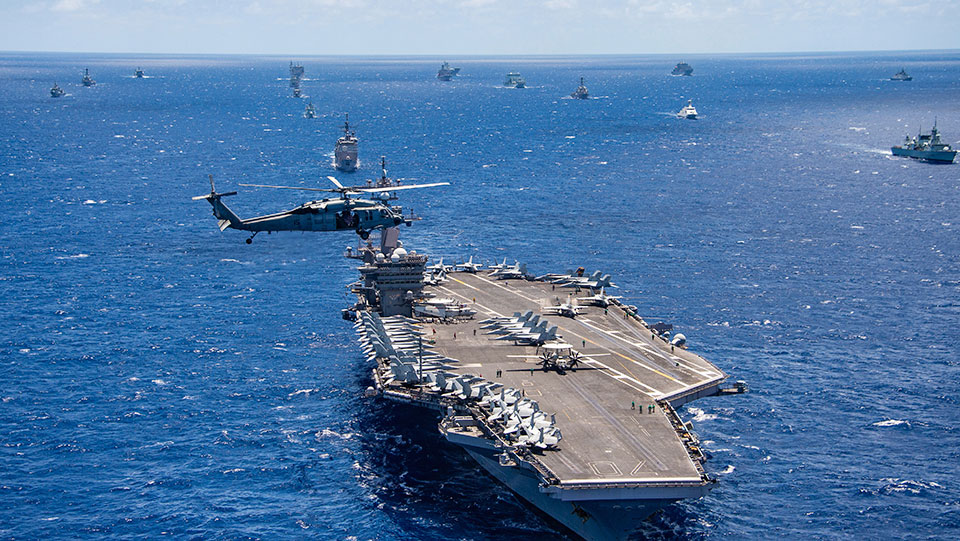
From June 28th to the 30th, NATO leaders met in Madrid, producing a new Strategic Concept and declaring that Russia and China are the key threats to Western security, interests, and values. For the first time, the NATO summit was expanded to include Asia Pacific “sentinel states” encircling China—Australia, Japan, South Korea, and New Zealand—and the North Atlantic was expanded to include the Indo-Pacific region.
It must not be forgotten that this is the same NATO that, without U.N. Security Council approval, waged an illegal war on Afghanistan and bombed Libya. This is the same NATO that waged an illegal war on Iraq that cost between 185,000 and 208,000 civilian deaths and destabilized the Middle East. It is the same NATO that is now acting as the tool for expanding U.S. imperialism’s reach even further around the world.
In a fact sheet released on July 12, the U.S. government outlined its latest efforts to retain its economic and political control of the Pacific region and to contain and control China. The fact sheet includes:
- “The U.S. government will adopt its first National Strategy on the Pacific Islands which will “prioritize the Pacific Islands in American foreign policy.
- “The U.S. will establish new embassies in Kiribati and Tonga and intends to reopen its embassy in the Solomon Islands.
- “The U.S. government will triple its current funding to $60 million per year for the next ten years linked to a new Economic Assistance Agreement with the Forum Fisheries Agency.
- “The U.S. government will appoint its first U.S. Pacific Islands Forum Envoy and increase our overall diplomatic footprint across the Pacific Islands.
- “The U.S. will send the Peace Corps to the Pacific, first to Fiji, Tonga, Samoa, and Vanuatu, and later expanding to additional Pacific island countries.
- “The U.S. will re-establish its Agency for International Development (USAID) Regional Mission for the Pacific in Fiji in order to improve close cooperation.
- “The United States and its allies—Australia, Japan, New Zealand, and the U.K.—have established a new coordination mechanism, the Partners in the Blue Pacific which it plans to expand to include members and observers, including in Europe and the Indo-Pacific.”
RIMPAC
Supporting this expansion, NATO is carrying out war games throughout July, the Rim of the Pacific (RIMPAC) exercises. The largest air, land, and sea war maneuvers in the world, they involve 238 ships, 170 aircraft, four submarines, and 25,000 military personnel from 26 countries.
It is undeniable: NATO is becoming a Pacific military force.
Nearly half of the 26 countries participating are NATO members or partners. Eight are members of NATO—Canada, Colombia, Denmark, France, Germany, Italy, the United Kingdom, and the United States. Four countries are Asia-Pacific “partners” of NATO—Australia, Japan, South Korea, and New Zealand.
RIMPAC increases the likelihood of armed conflict between the U.S. and China, and Pacific communities are calling for an alternative future that replaces militarized security with genuine human security.
In Hawai’i, the Malu ‘Aina Center for Non-Violent Education and Action says:
“Join the call to cancel RIMPAC and establish a demilitarized Pan-Pacific Zone of Peace. Redirect the massive expenditure of funds from war-making to serve humanity suffering from lack of food, water, and other unmet human needs amid a global pandemic, and expanding climate catastrophe. No More War and Training for War! Restore the Pacific as an Ocean of Peace!”
Militarizing Australia and the Indo-Pacific
Expanding Australian militarization is also increasing the chances of conflict with China in the Indo-Pacific and the threat of a wider, cataclysmic war.
RIMPAC is supplemented by regular U.S. naval patrols in China’s Exclusive Economic Zone (EEZ). Australia, in coordination with Washington, is installing the EEZ sensing devices so the U.S. can destroy Chinese vessels as quickly as possible at the start of any conflict.
Australia has joined provocative U.S. warships’ “freedom of navigation” exercises off the coast of China. The exercises have nothing to do with the freedom to transit in the region; they are part of U.S. efforts to maintain its military dominance of the region. Along with these provocations, the 290 U.S. military bases encircling China further increase threats to security and peace.
An important element in this militarization is AUKUS, the military pact between Australia, the U.K., and the U.S. announced in September 2021. The major component of AUKUS is the agreement to transfer U.S. technology for nuclear-powered submarines to Australia.
Under AUKUS, Australia will be further militarized and garrisoned with more deployments of U.S. aircraft in Australia; more U.S. surface and subsurface vessels in Australia; more joint war games; four new military bases; two new bases for the militarization of space; greater cooperation in hypersonic weapons, cyber warfare, underwater systems, artificial intelligence, and long-range strike capabilities; and support for combined military operations in the region.
Hugh White, in his Quarterly Essay article, “Sleepwalk to War: Australia’s Unthinking Alliance with America,” regards AUKUS as a colossal folly. The planned eight nuclear submarines, expected to be delivered around 2040, will take too long to arrive and will be too few to make much of a difference in a war with China.
AUKUS, he says, is tying Australia closer to America when the country should be pursuing a more independent foreign policy.
Recently, Defense Minister Richard Marles said the government will announce by March which nuclear-powered submarines Australia will acquire and whether it will spend even more money to build a conventionally powered submarine fleet to bridge the gap between the retirement of the Collins class and the arrival of nuclear-powered vessels.
“The Quad” military group is composed of the United States, Japan, India, and Australia. It has intelligence exchanges, interoperable equipment, and an increasing number of military exercises, strategic dialogues, technical agreements, and coordinated activities.
The U.S., Japan, and Australia have signed an infrastructure agreement. Japan has been permanently included in India-U.S. naval exercises. India’s air force participated in Australia’s Pitch Black exercises. India is buying U.S. weaponry.
Japan and Australia have held naval exercises and are planning air exercises and negotiating a visiting forces agreement. Japan has agreements with India on defense equipment and the security of classified communications. India and Australia have regular port visits and increasing military exercises.
Whose rules?
NATO Secretary General Jens Stoltenberg has said: “China is openly contesting the rules-based international order” and challenging “our values, our interests, and our security.” Australian strategic analyst Clinton Fernandes, meanwhile, notes that the so-called “rules-based order” differs sharply from the United Nations international order underpinned by international law.
For the U.S. and its allies, the U.N. Charter has two flaws. One is that it bans “the threat or use of force” in international affairs. That means that it bans U.S. foreign policy.
Noam Chomsky points out: “The rules-based international order overcomes this flaw. It permits the threat and use of force […]. Illustrations are so dramatically obvious that one might think that they would be difficult to ignore. That would be a mistake: they are routinely ignored. […]
“The second flaw is that the U.N. Security Council and the World Court set the rules. That flaw is also overcome in the rules-based international order, in which the U.S. sets the rules and others obey.”
The rules-based order apparently also has no concern for the threat that war preparations pose to the planet’s survival.
The RIMPAC war games are contributing to the destruction of the ecology and aggravation of the climate crisis in the Pacific region. RIMPAC will wreak havoc on whales, dolphins, Hawaiian monk seals, and other marine mammals through explosions, sonar, and ship strikes, and they will pollute the ocean with contaminates from vessels.
Land forces will conduct ground assaults that will tear up beaches where green sea turtles come to breed. Other examples of the military’s destruction include Hawaii, where the U.S. Navy’s jet fuel storage has contaminated Oahu’s aquifers. In Henoko, Okinawa, activists have been fighting U.S. Marines to preserve the coral reef and the endangered dugong.
We can probably expect the same kind of outcomes in Australia.
What role for Australia?
The defense policies of the new Australian Labor Party government show little improvement on the previous right-wing Scott Morrison government’s disastrous approach.
While Prime Minister Albanese and his cabinet are making efforts to rebuild their influence among Pacific states and Foreign Minister Penny Wong has had one meeting with her Chinese counterpart, there is no sign of change in what Paul Malone calls “some move away from Australia’s position as a vassal state of the United States, some move to temper the war-mongering rhetoric.”
Speaking recently in Washington, Deputy PM and Defense Minister Richard Marles claimed China was engaging in the biggest military build-up since the end of World War II. “It is massive. It is completely changing the strategic circumstances of the Indo-Pacific and I think, beyond that, the world,” he said.
He claimed that the U.S.-Australia alliance “will need to contribute to a more effective balance of military power, aimed at avoiding a catastrophic failure of deterrence,” he said. “We will make the investment necessary to increase the range and lethality of the Australian Defense Force,” Marles said.
In The Communist Manifesto Karl Marx warns that the constant class struggle can end “in the common ruin of the contending classes.” Chomsky echoes this when he writes: “We will find ways to cooperate to avert disaster and create a better world, as we still can. Or we will bring the human experiment to an inglorious end.”
If spending on the military could provide us with peace, wouldn’t we have achieved that already?
It should be obvious by now that countries trying to outspend one another by buying more and more deadly weapons systems do not create peace or security. It has not worked in the past, and it never will.
It is time for us to join together and call on governments around the world to cut military spending and instead invest in the true needs of the people and the planet to build a just and sustainable peace.
As with all op-eds published by People’s World, this article reflects the opinions of its author.










